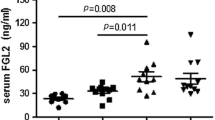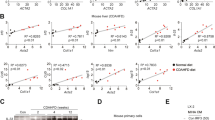Hepatic stellate cells (HSCs) are now considered the major cell type in the liver mediating the development of liver fibrosis. Recently it was demonstrated that HSCs express membrane proteins involved in antigen presentation. We further evaluate immunological properties of HSCs by examining the expression and function of the Fc fragment of immunoglobulin G (IgG) in HSCs. In this study, we document the presence of mRNAs for three FcγRs in HSCs. Ligand binding assay indicated the existence of FcγRs with different binding affinities on membranes of HSCs. We also documented that the abundance of the three Fcγ R mRNAs increased upon activation of HSCs in vitro. Moreover, an examination of the biological activities of IgG revealed that exposure to IgG significantly stimulated HSC differentiation and proliferation. Furthermore, we studied the intracellular signaling protein, LcK, in HSCs and regulation of Lck expression and phosphorylation by IgG. Although IgG did not regulate Lck abundance and phosphorylation in HSCs, highly phosphorylated Lck was present in these cells. In conclusion, we provided evidence that HSCs expresses receptors for the Fc fragment of IgG, and IgG regulates HSC differentiation and proliferation. Therefore, immunoglobulin G may play a role in HSC activation.
Similar content being viewed by others
References
Friedman SL: Molecular regulation of hepatic fibrosis, an integrated cellular response to tissue injury. J Biol Chem 275(4):2247–2250, 2000
Gressner AM: The up-and-down of hepatic stellate cells in tissue injury: apoptosis restores cellular homeostasis. Gastroenterology 120(5):1285–1288, 2001
Reeves HL, Friedman SL: Activation of hepatic stellate cells—A key issue in liver fibrosis. Front Biosci 7:d808–d826, 2002
Pinzani M: Liver fibrosis. Springer Semin Immunopathol 21(4):475–490, 1999
Rockey DC: Hepatic blood flow regulation by stellate cells in normal and injured liver. Semin Liver Dis 21(3):337–349, 2001
Reynaert H, Thompson MG, Thomas T, Geerts A: Hepatic stellate cells: role in microcirculation and pathophysiology of portal hypertension. Gut 50(4):571–581, 2002
Vinas O, Bataller R, Sancho-Bru P, et al. : Human hepatic stellate cells show features of antigen-presenting cells and stimulate lymphocyte proliferation. Hepatology 38(4):919–929, 2003
Torok NJ, Taimr P, Friedman SL, Gore GJ: Hepatocyte apoptosis enhances fibrogenic activity of human stellate cells following engulfment of apoptotic bodies. A novel link between two key features of chronic liver disease. Hepatology 34:153A, 2001 (abstr)
Gessner JE, Heiken H, Tamm A, Schmidt RE: The IgG Fc receptor family. Ann Hematol 76(6):231–248, 1998
Greenberg S: Modular components of phagocytosis. J Leukoc Biol 66(5):712–717, 1999
Morel PA, Ernst LK, Metes D: Functional CD32 molecules on human NK cells. Leuk Lymphoma 35(1–2):47–56, 1999
Tuijnman WB, Van Wichen DF, Schuurman HJ: Tissue distribution of human IgG Fc receptors CD16, CD32 and CD64: an immunohistochemical study. Apmis 101(4):319–329, 1993
Shen H, Huang G, Hadi M, et al. : Transforming growth factor-beta1 downregulation of Smad1 gene expression in rat hepatic stellate cells. Am J Physiol Gastrointest Liver Physiol 285(3):G539–G546, 2003
Gavin AL, Hamilton JA, Hogarth PM: Extracellular mutations of non-obese diabetic mouse FcgammaRI modify surface expression and ligand binding. J Biol Chem 271(29):17091–17099, 1996
Fryer HJ, Davis GE, Manthorpe M, Varon S: Lowry protein assay using an automatic microtiter plate spectrophotometer. Anal Biochem 153(2):262–266, 1986
Shen H, Huang GJ, Gong YW: Effect of transforming growth factor beta and bone morphogenetic proteins on rat hepatic stellate cell proliferation and trans-differentiation. World J Gastroenterol 9(4):784–787, 2003
Sobhonslidsuk A, Roongpisuthipong C, Nantiruj K, et al. : Impact of liver cirrhosis on nutritional and immunological status. J Med Assoc Thai 84(7):982–988, 2001
Triger DR, Wright R: Hyperglobulinaemia in liver disease. Lancet 1(7818):1494–1496, 1973
Husby G, Skrede S, Blomhoff JP, Jacobsen CD, Berg K, Gjone E: Serum immunoglobulins and organ non-specific antibodies in diseases of the liver. Scand J Gastroenterol 12(3):297–304, 1977
Revillard JP, Millet I: Fc receptor-bearing T cells and Ig binding factors as class-specific suppressors of polyclonally activated human B cells. Int Rev Immunol 2(2):183–201, 1987
Kijimoto-Ochiai S, Uede T: CD23 molecule acts as a galactose-binding lectin in the cell aggregation of EBV-transformed human B-cell lines. Glycobiology 5(4):443–448, 1995
Bajorath J, Aruffo A: Structure-based modeling of the ligand binding domain of the human cell surface receptor CD23 and comparison of two independently derived molecular models. Protein Sci 5(2):240–247, 1996
Leach JL, Sedmak DD, Osborne JM, Rahill B, Lairmore MD, Anderson CL: Isolation from human placenta of the IgG transporter, FcRn, and localization to the syncytiotrophoblast: implications for maternal-fetal antibody transport. J Immunol 157(8):3317–3322, 1996
Dickinson BL, Badizadegan K, Wu Z, et al. : Bidirectional FcRn-dependent IgG transport in a polarized human intestinal epithelial cell line. J Clin Invest 104(7):903–911, 1999
Masuda M, Roos D: Association of all three types of Fc gamma R (CD64, CD32, and CD16) with a gamma-chain homodimer in cultured human monocytes. J Immunol 151(12):7188–7195, 1993
Hulett MD, Hogarth PM: The second and third extracellular domains of FcgammaRI (CD64) confer the unique high affinity binding of IgG2a. Mol Immunol 35(14–15):989–996, 1998
van Vugt MJ, Kleijmeer MJ, Keler T, et al. : The FcgammaRIa (CD64) ligand binding chain triggers major histocompatibility complex class II antigen presentation independently of its associated FcR gamma-chain. Blood 94(2):808–817, 1999
Edberg JC, Moon JJ, Chang DJ, Kimberly RP: Differential regulation of human neutrophil FcgammaRIIa (CD32) and FcgammaRIIIb (CD16)-induced Ca$^{2+}$ transients. J Biol Chem 273(14):8071–8079, 1998
Tosi MF, Zakem H: Surface expression of Fc gamma receptor III (CD16) on chemoattractant-stimulated neutrophils is determined by both surface shedding and translocation from intracellular storage compartments. J Clin Invest 90(2):462–470, 1992
Engelhardt W, Matzke J, Schmidt RE: Activation-dependent expression of low affinity IgG receptors Fc gamma RII(CD32) and Fc gamma RIII(CD16) in subpopulations of human T lymphocytes. Immunobiology 192(5):297–320, 1995
Carosella ED, Gay C, Armand J, Touraine JL: Human B-cell differentiation by Fc fragment of IgG. I. Fc fragment from human IgG induces plasma cell generation but cannot induce lymphocyte proliferation. Cell Immunol 112(2):262–270, 1988
Uher F, Lamers MC, Dickler HB: Antigen-antibody complexes bound to B-lymphocyte Fc gamma receptors regulate B-lymphocyte differentiation. Cell Immunol 95(2):368–379, 1985
Berman MA, Weigle WO: B-lymphocytes activation by the Fc region of IgG. J Exp Med 146(1):241–256, 1977
Moore RW, Caldwell DY, Berghman LR, et al. : Effect of bursal anti-steroidogenic peptide and immunoglobulin G on neonatal chicken B-lymphocyte proliferation. Comp Biochem Physiol C Toxicol Pharmacol 134(3):291–302, 2003
Bijsterbosch MK, McLaughlin JB, Holman M, Klaus GG. Activation and proliferation signals in mouse B cells. IX. Protein kinase C activators synergize with non-mitogenic anti-immunoglobulin antibodies to drive B cells into G1. Immunology 64(1):163–168, 1988
Michaelsen TE, Wisloff F, Natvig JB: Structural requirements in the Fc region of rabbit IgG antibodies necessary to induce cytotoxicity by human lymphocytes. Scand J Immunol 4(1):71–78, 1975
Nakamura K, Yube K, Miyatake A, Cambier JC, Hirashima M: Involvement of CD4 D3-D4 membrane proximal extracellular domain for the inhibitory effect of oxidative stress on activation-induced CD4 down-regulation and its possible role for T cell activation. Mol Immunol 39(15):909–921, 2003
Metes D, Manciulea M, Pretrusca D, et al. : Ligand binding specificities and signal transduction pathways of Fc gamma receptor IIc isoforms: the CD32 isoforms expressed by human NK cells. Eur J Immunol 29(9):2842–2852, 1999
Hardwick JS, Sefton BM: Activation of the Lck tyrosine protein kinase by hydrogen peroxide requires the phosphorylation of Tyr-394. Proc Natl Acad Sci USA 92(10):4527–4531, 1995
Franklin RA, McLeod A, Robinson PJ: Calcium-induced p56(Lck) phosphorylation in human T lymphocytes via calmodulin dependent kinase. Biochem Biophys Res Commun 259(2):283–286, 1999
Author information
Authors and Affiliations
Corresponding author
Rights and permissions
About this article
Cite this article
Shen, H., Zhang, M., Kaita, K. et al. Expression of Fc Fragment Receptors of Immunoglobulin G (FcγRs) in Rat Hepatic Stellate Cells. Dig Dis Sci 50, 181–187 (2005). https://doi.org/10.1007/s10620-005-1298-5
Received:
Accepted:
Issue Date:
DOI: https://doi.org/10.1007/s10620-005-1298-5




